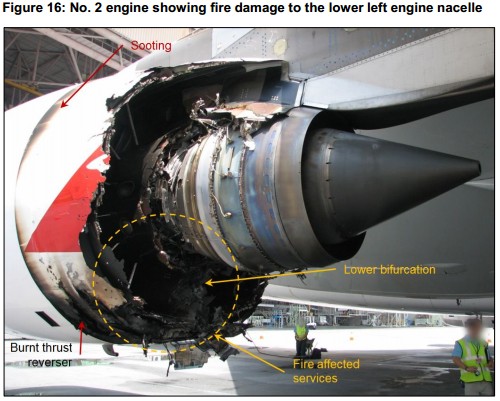Hi FullWings,
When you get an engine fire warning, does it mean that the wing (or wherever the engine is mounted) is a mass of flames? No, it signifies that the temperature inside the nacelle has gone over a pre-defined limit, not an amazingly hot one either.
There have been many examples of serious engine damage / fire which require fuel, hydraulics, and electrics etc. to be isolated before more damage is done. e.g.
ASN Aircraft accident Boeing 707-465 G-ARWE London-Heathrow Airport (LHR)
"About 1,5 minutes after the start of the fire, No. 2 engine, together with part of its pylon, became detached and fell into a waterfilled gravel pit."
"PROBABLE CAUSE: "The accident resulted from an omission to close the fuel shut off valve when No. 2 engine caught fire following the failure of its No. 5 low pressure compressor wheel."
and:
 http://www.atsb.gov.au/media/4173625...-089_final.pdf
http://www.atsb.gov.au/media/4173625...-089_final.pdf
"The electronic centralised aircraft monitoring (ECAM)3 (Figure 1) displayed a message indicating a No. 2 engine turbine overheat warning. ...The first officer also reported observing an ECAM warning of a fire in the No. 2 engine that was displayed for about 1 to 2 seconds, before the ECAM reverted to the overheat warning and reinitiated the 30 second monitoring period."
"1.11.1 No. 2 engine external fire
Following the uncontained engine failure, an external fire developed in the lower left region of the No. 2 engine nacelle. A portion of the thrust reverser assembly was burnt in the fire (Figure 16). Initial on-site inspection identified that the fire was most intense in the lower left thrust reverser section and in the lower bifurcation13 (Figure 17 and 18). Sooting, glazing and the effects of heat were observed on a number of electrical, air, oil and hydraulic supply lines and the nacelle anti-ice bleed air ducts within the core section, lower bifurcation and accessories section (on the fan casing)."
and:
http://www.aaib.gov.uk/cms_resources...pdf_026142.pdf
"No damage was evident externally, however, on opening the No 1 engine cowling there was evidence of significant fire damage centred around the underside of the engine. The fire has resulted in sooting and an oily residue around the outside of the engine casing and damage to wiring. The fuel control unit input rods showed signs of heat damage to the bearings. There was also evidence of penetration from inside the engine casing in the area of the discharge vanes in approximately the 5 o'clock position (viewed from the front). A small piece of debris was found within the cowling. Further examination revealed two penetrations of the engine casing around the 5 and 7 o'clock positions with damage to the oil tank and a ruptured fuel pipe (see Figure 1)."
"There have been previous incidents where LP compressor second stage blade root fractures have resulted in the release of a blade from the disk. In some cases released fragments have penetrated the engine cowl, damaged or severed fuel lines, and caused engine fires within the cowl. The manufacturer's Alert Service Bulletin (ASB) 5729 Rev 2, dated July 8 1988, identified this problem. At that time there had been a total of 115 fractures of second stage fan blade root attachments. Twenty of these resulted in cowl penetration but with no reports of significant aircraft damage. Nine resulted in fires, all of which were extinguished by means of the engine aircraft fire extinguishing systems."
If it takes us until we're clean (or later) to diagnose the issue(s) and start actions, then that's not a problem.
Whilst I agree it is pointless to do an immaculate shut down procedure and subsequently crash into the terrain, it is important to secure the engine in a timely manner. Once the engine is secured, then subsequent actions can be left until you are clean or later.